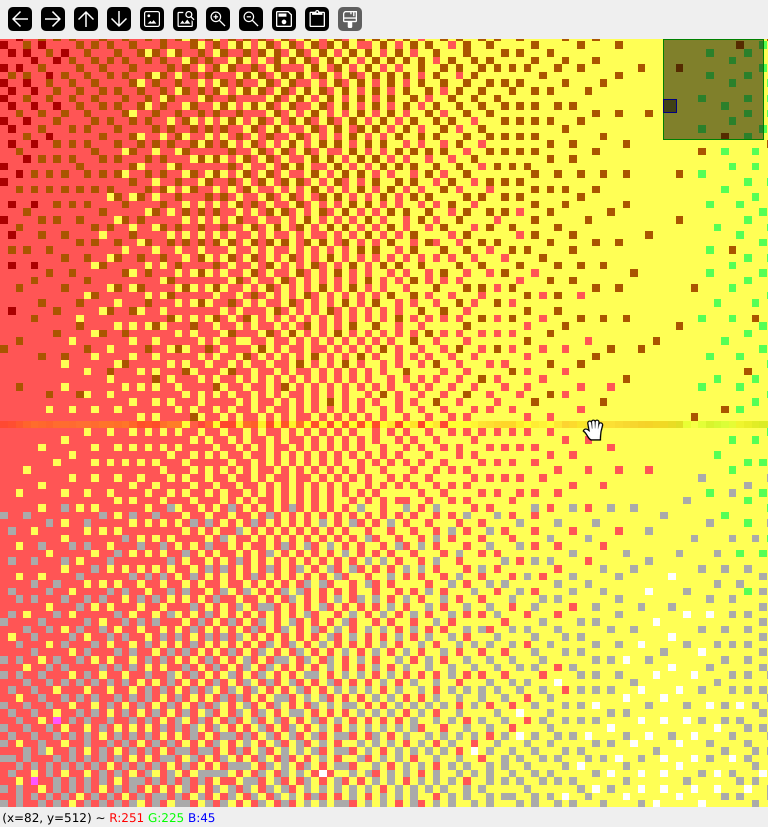在做dithering仿色抖动练习,使用floyd steinberg算法。
请各位师傅指点下,能怎么改代码,能消除这条坏线
复现
python原生cpu,计算正确
运行 time ./cpu_no_taichi.py,耗时50s。
cpu_no_taichi.py
#!/bin/env python
TAICHI = False
import cv2
import numpy as np
def static(x):
return x
if TAICHI:
import taichi as ti
from taichi import static
ti.init(arch=ti.cpu,debug=False,offline_cache=False)
DEBUG=True
MAX=255
np.set_printoptions(threshold=np.inf, linewidth=180) # numpy打印选项
img_from='./input.jpg'
def show_image(img):
"""显示图片"""
if isinstance(img, str):
img = cv2.imread(img)
elif img.dtype != 'uint8':
img = np.clip(img, 0, MAX) # 将图片像素值限制在 0~255 之间
img = img.astype(np.uint8)
cv2.imshow('Image', img)
while True:
key = cv2.waitKey(1) & 0xFF
if key == 27: # 27 是 ESC 键的 ASCII 码
break
cv2.destroyAllWindows()
PALETTE=[ # RGB
0x000000, 0x0000AA, 0x00AA00, 0x00AAAA,
0xAA0000, 0xAA00AA, 0xAA5500, 0xAAAAAA,
0x555555, 0x5555FF, 0x55FF55, 0x55FFFF,
0xFF5555, 0xFF55FF, 0xFFFF55, 0xFFFFFF
]
PALETTE = [(c & 0xFF, c>>8 & 0xFF, c>>16 & 0xFF) for c in PALETTE] #BGR
print('PALETTE自定义调色板',PALETTE) if DEBUG else None
type_img2d = object
type_bayerM = object
if TAICHI:
type_img2d = ti.types.ndarray(dtype=ti.math.vec3,ndim=2)
type_bayerM = ti.types.ndarray(element_dim=0,ndim=2)
# @ti.func
def clamp(x, min, max):
# return ti.math.clamp(x, min, max) # taichi
return np.clip(x, min, max)
# @ti.func
def get_closest_bgr(old_pixel):
# new_pixel = ti.Vector([0,0,0],dt=ti.i32) # taichi
new_pixel = (0,0,0) # cpu
min_distance = 0xFFFFFFF
r, g, b = old_pixel
for c in static(PALETTE):
cr, cg, cb = c
distance = (r - cr) ** 2 + (g - cg) ** 2 + (b - cb) ** 2
if distance < min_distance:
min_distance = distance
new_pixel = c
return new_pixel
# @ti.kernel
def dither_floyd(img:type_img2d):
PICK = 512
h = img.shape[0]
w = img.shape[1]
for i in range(h):
print(f'{i}/{h} \t{i/h*100:.2f}%',end='\r')
for j in range(w):
flag=False
for k in range(3):
if img[i, j][k] < 0 and i%PICK==0 and j%PICK==0:
print(f'🔍 img[{i},{j}]→{img[i, j]}',end='→')
flag=True
break
oldpixel = img[i, j]
oldpixel = clamp(img[i, j],0,MAX)
newpixel = clamp(get_closest_bgr(oldpixel),0,MAX)
quant_error = oldpixel - newpixel
img[i, j] = newpixel
if flag==True and i%PICK==0 and j%PICK==0:
print(f'newpixel={newpixel}\tquant_error={quant_error}')
if j+1<w:
img[i, j + 1] += quant_error * 7 // 16
if i+1<h:
if j-1>=0:
img[i + 1, j - 1] += quant_error * 3 // 16
img[i + 1, j] += quant_error * 5 // 16
if j+1<w:
img[i + 1, j + 1] += quant_error // 16
print(f'🔍 img[{PICK},{PICK}]→{img[PICK, PICK]}')
def gen_bgr_256(value=MAX,show_raw=False):
"""生成256色BGR调色板"""
scope=256
img = np.zeros((256, 256, 3), dtype=np.uint8)
for i in range(scope):
for j in range(scope):
img[i, j] = (j, i, value)
img = cv2.cvtColor(img, cv2.COLOR_HLS2BGR)
show_image(img) if show_raw else None
return img
n = 3
# img = cv2.imread(img_from)
img = gen_bgr_256()
img = cv2.resize(img, (img.shape[1] * n, img.shape[0] * n), interpolation=cv2.INTER_NEAREST) # 放大n倍
img = img.astype(np.int32) # 转换为 int32 类型
dither_floyd(img)
show_image(img)
taichi_cpu,图像第512行,有一条横的坏线,耗时1.6s
cpu_taichi.py
#!/bin/env python
TAICHI = True
import cv2
import numpy as np
def static(x):
return x
if TAICHI:
import taichi as ti
from taichi import static
ti.init(arch=ti.cpu,debug=False,offline_cache=False)
DEBUG=True
MAX=255
np.set_printoptions(threshold=np.inf, linewidth=180) # numpy打印选项
img_from='./input.jpg'
def show_image(img):
"""显示图片"""
if isinstance(img, str):
img = cv2.imread(img)
elif img.dtype != 'uint8':
img = np.clip(img, 0, MAX) # 将图片像素值限制在 0~255 之间
img = img.astype(np.uint8)
cv2.imshow('Image', img)
while True:
key = cv2.waitKey(1) & 0xFF
if key == 27: # 27 是 ESC 键的 ASCII 码
break
cv2.destroyAllWindows()
PALETTE=[ # RGB
0x000000, 0x0000AA, 0x00AA00, 0x00AAAA,
0xAA0000, 0xAA00AA, 0xAA5500, 0xAAAAAA,
0x555555, 0x5555FF, 0x55FF55, 0x55FFFF,
0xFF5555, 0xFF55FF, 0xFFFF55, 0xFFFFFF
]
PALETTE = [(c & 0xFF, c>>8 & 0xFF, c>>16 & 0xFF) for c in PALETTE] #BGR
print('PALETTE自定义调色板',PALETTE) if DEBUG else None
type_img2d = object
type_bayerM = object
if TAICHI:
type_img2d = ti.types.ndarray(dtype=ti.math.vec3,ndim=2)
type_bayerM = ti.types.ndarray(element_dim=0,ndim=2)
@ti.func
def clamp(x, min, max):
return ti.math.clamp(x, min, max) # taichi
return np.clip(x, min, max)
@ti.func
def get_closest_bgr(old_pixel):
new_pixel = ti.Vector([0,0,0],dt=ti.i32) # taichi
# new_pixel = (0,0,0) # cpu
min_distance = 0xFFFFFFF
r, g, b = old_pixel
for c in static(PALETTE):
cr, cg, cb = c
distance = (r - cr) ** 2 + (g - cg) ** 2 + (b - cb) ** 2
if distance < min_distance:
min_distance = distance
new_pixel = c
return new_pixel
@ti.kernel
def dither_floyd(img:type_img2d):
PICK = 512
h = img.shape[0]
w = img.shape[1]
for i in range(h):
print(f'{i}/{h} \t{i/h*100:.2f}%',end='\r')
for j in range(w):
flag=False
for k in range(3):
if img[i, j][k] < 0 and i%PICK==0 and j%PICK==0:
print(f'🔍 img[{i},{j}]→{img[i, j]}',end='→')
flag=True
break
oldpixel = img[i, j]
oldpixel = clamp(img[i, j],0,MAX)
newpixel = clamp(get_closest_bgr(oldpixel),0,MAX)
quant_error = oldpixel - newpixel
img[i, j] = newpixel
if flag==True and i%PICK==0 and j%PICK==0:
print(f'newpixel={newpixel}\tquant_error={quant_error}')
if j+1<w:
img[i, j + 1] += quant_error * 7 // 16
if i+1<h:
if j-1>=0:
img[i + 1, j - 1] += quant_error * 3 // 16
img[i + 1, j] += quant_error * 5 // 16
if j+1<w:
img[i + 1, j + 1] += quant_error // 16
print(f'🔍 img[{PICK},{PICK}]→{img[PICK, PICK]}')
def gen_bgr_256(value=MAX,show_raw=False):
"""生成256色BGR调色板"""
scope=256
img = np.zeros((256, 256, 3), dtype=np.uint8)
for i in range(scope):
for j in range(scope):
img[i, j] = (j, i, value)
img = cv2.cvtColor(img, cv2.COLOR_HLS2BGR)
show_image(img) if show_raw else None
return img
n = 3
# img = cv2.imread(img_from)
img = gen_bgr_256()
img = cv2.resize(img, (img.shape[1] * n, img.shape[0] * n), interpolation=cv2.INTER_NEAREST) # 放大n倍
img = img.astype(np.int32) # 转换为 int32 类型
dither_floyd(img)
show_image(img)
taichi_gpu,不止一条坏线,且间隔随机
将 cpu_taichi.py 第11行ti.cpu改为ti.gpu,耗时1.5s
cpu、gpu不一致
论坛参考:


